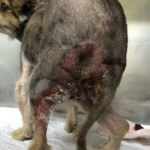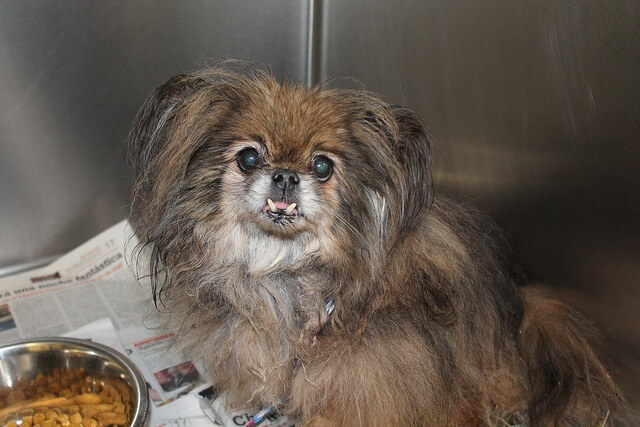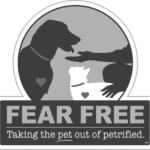Oliver has officially been adopted! See the comments at the bottom of this blog for more on his happy ending.
This story has a happy ending, but a not-so-pleasant beginning. Most of you know that Malvern Veterinary Hospital is fortunate to work with an amazing rescue group called Senior Dog Haven and Hospice (SDHH for short). SDHH is called upon by shelters in the area to rescue geriatric, often debilitated dogs that might otherwise be slated for euthanasia. All SDHH rescues receive complete medical care, including full senior bloodwork, comprehensive dental cleanings, tumor removals and even visits with our local ophthalmologist if needed. During their medical treatments, SDHH dogs are kept in foster homes where loving foster parents get to know their personalities well. Once healthy, the majority of SDHH rescue dogs are found caring, forever homes. A small number of SDHH dogs are considered “hospice”, meaning they have a terminal or untreatable illness that renders them unadoptable; in these cases, SDHH foster homes provide compassionate care, and pain relief until it is time to say goodbye.
Recently, SDHH brought us a new foster dog directly from a Philadelphia shelter. The dog, pictured above, was named “Olivia” and had been brought to the shelter as a stray by Philadelphia police, after she wandered onto a construction site and bit a construction worker. According to Olivia’s paperwork, the shelter staff could not touch her due to her aggressive nature. She was noted to have a “tumor, possibly infected” and was estimated to be a geriatric Pomeranian mix. There was no other information available about Olivia, since she was a stray. SDHH volunteers brought her directly from the shelter to Malvern Veterinary Hospital.
When Olivia presented to us, she was visibly, horrendously matted. A foul odor was emanating from her body, and there appeared to be a large mass in her anal area. Gross-out alert: we also noted that the mass was covered in live maggots. So much fur was matted in the anal region, it was difficult to determine the severity of the problem. Olivia was aggressive with us, so we had a limited ability to examine her without sedation. We knew Olivia needed a shave down, and thorough physical examination; to facilitate this, and minimize stress to Olivia, she was completely sedated.
Once sedated, Olivia was found to be a tiny dog, buried under a mountain of matted fur. We grabbed clippers and began shaving Olivia down. As we clipped away the mountain of mats adhered to her tiny body, we were surprised to discover that Olivia was, in fact, a male dog! No one was able to get close enough to him previously to accurately determine his gender, and his genitals were completely covered in matted fur anyway. We immediately renamed Olivia Oliver.
 As I continued clipping, it became obvious that Oliver did not have a tumor in his anal area, but instead had several enormous fecoliths (balls of hardened fecal material) attached to the fur on his groin and hind legs. Two of these fecoliths were the size of softballs (hard to imagine, attached to a dog weighing only five pounds) and there were many others the size of golf balls. The fecoliths were completely obstructing Oliver’s anal opening, so it was unlikely he was able to defecate without a struggle. The skin under the matted fur and fecoliths was completely raw and ulcerated, akin to the most severe case of diaper rash known to humankind. I can only imagine how excruciatingly painful this was for Oliver, and could certainly be an explanation for some of his aggression. Other than the matted fur, skin infection and some moderate dental disease, Oliver appeared otherwise healthy. The graphic photo to the left is of Oliver’s anal area, pre-shaving; to orient you, Oliver’s head is to the left and his tail is to the right in this photo.
As I continued clipping, it became obvious that Oliver did not have a tumor in his anal area, but instead had several enormous fecoliths (balls of hardened fecal material) attached to the fur on his groin and hind legs. Two of these fecoliths were the size of softballs (hard to imagine, attached to a dog weighing only five pounds) and there were many others the size of golf balls. The fecoliths were completely obstructing Oliver’s anal opening, so it was unlikely he was able to defecate without a struggle. The skin under the matted fur and fecoliths was completely raw and ulcerated, akin to the most severe case of diaper rash known to humankind. I can only imagine how excruciatingly painful this was for Oliver, and could certainly be an explanation for some of his aggression. Other than the matted fur, skin infection and some moderate dental disease, Oliver appeared otherwise healthy. The graphic photo to the left is of Oliver’s anal area, pre-shaving; to orient you, Oliver’s head is to the left and his tail is to the right in this photo.
 Oliver was prescribed a course of antibiotics, pain medication and topical ointment to heal his scalded skin. The photo, left, is of Oliver immediately after his shaving; OUCH! Once awake, he immediately went to a foster home where his raw skin was diligently treated. Oliver’s foster mom Eleanor gave us regular updates, and told us that he was sweet to them, great with their other dogs and even friendly with small children. Initially, Oliver was a bit cranky when his rear end was touched (who could blame him), but even this resolved as his skin healed.
Oliver was prescribed a course of antibiotics, pain medication and topical ointment to heal his scalded skin. The photo, left, is of Oliver immediately after his shaving; OUCH! Once awake, he immediately went to a foster home where his raw skin was diligently treated. Oliver’s foster mom Eleanor gave us regular updates, and told us that he was sweet to them, great with their other dogs and even friendly with small children. Initially, Oliver was a bit cranky when his rear end was touched (who could blame him), but even this resolved as his skin healed.
There are several morals to this story. First, long haired-dogs need frequent grooming to prevent mats. I have seen many patients with fecal matting over the years, but none come close in severity to Oliver. Second, older dogs can be highly adoptable companions, but they may need a bit of medical “work” initially. Sadly, they are frequently overlooked in shelters. (Most families want young dogs, but remember that puppies are a lot of work! Senior dogs are often housebroken, require less exercise and have less destructive tendencies than the young guns.) Third, an enormous THANK YOU to SDHH for their amazing work in rehabilitating senior dogs and finding them excellent homes.
 Finally, Oliver’s story makes an essential point: aggression is not always rooted in fear, dominance, territoriality or another behavioral diagnosis. Sometimes aggression in dogs and cats is a manifestation of pain. Oliver is a perfect example of this; treating Oliver’s pain appropriately allowed a completely different, friendly, highly adoptable dog to emerge. (When Oliver initially presented, I could not even approach him without risking a serious bite. At his two-week recheck, pictured here, we were best buds!)
Finally, Oliver’s story makes an essential point: aggression is not always rooted in fear, dominance, territoriality or another behavioral diagnosis. Sometimes aggression in dogs and cats is a manifestation of pain. Oliver is a perfect example of this; treating Oliver’s pain appropriately allowed a completely different, friendly, highly adoptable dog to emerge. (When Oliver initially presented, I could not even approach him without risking a serious bite. At his two-week recheck, pictured here, we were best buds!)
Oliver is currently doing a “test drive” with a potential adoptive family, and we hope that he finds the forever home that he deserves! We are rooting for you, Oliver.









